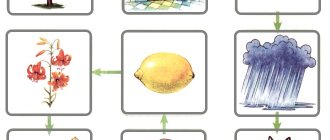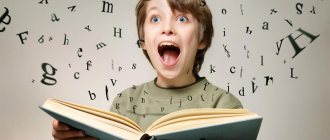At what age is it better to start learning letters, features of the process and recommendations
Parents often mistakenly believe that the sooner they introduce their child to letters, the faster he will remember them and learn to read. Child psychologists try to explain to adults that in order to learn the material, the child must grow up. It is not advisable to show cards with letters to a child under one year old, or to force a 2-year-old child to study as in a lesson at school. At this time, children are not yet able to perceive information in the same way as adults.
Incorrect teaching methods can discourage children from learning for a long time, and at school it will be more difficult for them to tune in to learning their native language. Classes should be interesting and easy. The best way to help a child learn the alphabet is through play. The lesson should last from 5 to 20 minutes, but no more. Games should be age-appropriate so that the child is interested and perceives new information with pleasure. The appropriate age for children to learn letters for the first time is from 3 years old. You can’t expect instant results from your baby.
It will take a lot of time for a child to master a good skill. Learning letters can be divided into stages. Each is age-appropriate as children learn to perceive the world in different ways over the course of several years. When inventing educational games, it is necessary to focus on children's worldview.
To make it clearer, you need to look at this table:
| Child's age | Active form of worldview | Examples of games with letters |
| 3 years | tactile | Puzzles, plastic letter figurines or modular rugs are suitable for educational activities. |
| 4 years | visual | Flashcards, ABC books, educational cartoons. |
| 5 years | logical | Fridge magnets, puzzles and other toys that will help you learn the alphabet in the correct order. |
| 6 years | binder | Cubes with letters, syllable boxes, magnets and other sets with which you can learn to read syllables. |
You can read more about each teaching method, suitable for a certain age of the child, further in the article.
At 3 years old
As mentioned earlier, this is the right age to learn about letters for the first time. During this period, children perceive information well by touch, in other words, their form of perception is tactile. This means that the letters written on paper are not yet of interest to the child. To him they look like incomprehensible lines and dots. Now it is important for the baby to touch the letters, knead them in his hands, and taste them. There are several types of teaching aids that will help to interest your child.
Examples:
- Wooden mosaic. The baby can touch the letters and try to find a place for them on a special board. He will begin to select shapes to install the part correctly. This method will help develop thinking and remember what a particular symbol looks like.
- Modular rugs. These are large puzzles made of soft, pleasant-to-touch material that can be crushed in your hands. Bright colors attract children's attention. Each puzzle has additional holes where you can insert matching letters piece by piece.
- Plastic figures. They work in a similar way to rugs. You can use different sticks and circles to create letter shapes.
It is important to play with your child together. When he picks up a “letter”, he must pronounce the sound that it represents. You can sing children's songs and read funny poems to your baby.
At 4 years old
By this age, children change their active form of perception from tactile to visual. Now the child knows what the letters look like and even recognizes some of them. For 4-year-old children, you can offer games with cards, show them ABC books, and play with blocks. It is important to emphasize learning the connections between symbols and sounds. To do this, objects whose names begin with certain sounds are depicted on cards and in alphabet books. When playing with cubes, you can choose letters and place a suitable toy next to them.
For example, choose a cube with the letter “d”, place a figurine of a dinosaur, a house, and so on next to it. First, you should pronounce the sounds yourself, and then ask the child to make his own “combination” from a cube and a toy. It is important to be patient and not get angry or irritated, so as not to discourage your child from wanting to study.
At 5 years old
Children of this age develop logical thinking. This is the time to learn the order of letters in the alphabet. The child can again be offered a wooden mosaic, but now his task is not to choose the correct shapes, but to arrange all the symbols in the correct order. At first, the baby will play according to the “old rules,” but knowing the outlines of the letters and being able to quickly select suitable puzzles, he will begin to learn the sequence in which the symbols are located.
When the child can easily handle such tasks, he will need to consolidate his knowledge. Now you can play with magnets in the form of letters, placing them in order on a special board or refrigerator door. Now the baby will not have clues in the form of empty slots for each letter. He will have to remember the sequence of symbols on his own.
At 6 years old
The connecting form of a child’s worldview works as a comparison, addition and search for connections between the knowledge he has already received and new ones. At 6 years old, children should have a good knowledge of the letters and their sequence in the alphabet. This age is suitable for introducing reading. You can offer your child cubes from which he will make words. You can also use refrigerator magnets and plastic figures. You should explain to your baby the difference between vowels and consonants, and also teach him to read syllables.
It is important that the child pronounces sounds correctly, so throughout the entire training it is necessary to voice the sound, and not the name of the symbol. Teachers of primary school and senior kindergarten groups often pay attention to this problem. For example, a child was taught at home: “This is the letter ER, and this is EL, and this is BE.” And now it’s difficult for the baby to read. He pronounces the letters incorrectly, as a result of which he reads the word “Barmoley” as “BE A ER EM O EL E Y.” There are special difficulties with the last letter (Y).
Learning letters - educational tasks
In the age of the Internet, it is not at all necessary to spend money on special children's educational aids and activities.
We provide our visitors with absolutely free tasks containing letters for children and allowing them to memorize the alphabet in a short time. Education for children must include elements of play. Therefore, we have selected only those practical tasks for learning letters that will interest the child. Thanks to special categories of practical tasks, you can not only study with your child on your own without unnecessary expenses, but also develop perseverance in him and prepare him for school. A set of exercises “learning letters for children” is aimed at developing the child and improving the process of memorizing letters as a result of the game. Each program is designed for preschool children. You can choose the letter learning games at your discretion or ask which one your child will like best.
Copybooks
How to learn letters with your child while playing?
Children from 3 to 6 years old need to learn letters through play. You can come up with your own useful entertainment, or you can use proven techniques. Some game-based learning methods were developed by child psychologists at the beginning of the 20th century and work flawlessly today. They are used in kindergartens and primary schools. These games are interesting and useful for children.
Games with semolina
We study letters for children 3 years old, based on their tactile form of world perception. To play you will need a tray with sides about 2 cm and semolina.
Game options:
- Pour 1-2 cups of cereal onto a tray and smooth it out. Use your fingers to write letters and pronounce sounds. Invite the child to write the same letter. You can draw not only with your hands, but also with ice cream sticks, brushes or milkshake tubes.
- Bury plastic or wooden letter figures, then ask your child to find them and name the sound that the letter represents.
- On a sheet of cardboard, draw the outline of any letter and coat it with glue. The child must sprinkle the letters with a thin stream of semolina to create an applique. While he is completing the task, you can talk to him about this letter, pronounce the sound and the name of objects that begin with this sound.
Older children can also play with semolina.
Examples of games:
- Lay out the outlines of symbols with cones, beads, and buttons on the surface of the cereal.
- Bury plastic or wooden figures and try to identify the symbols by touch.
- Write letters that can be changed into others. For example, an adult writes the letter “L”. The child’s task is to complete the line so that it turns out to be “A”.
- Bury cards with letters halfway and guess which symbol is “hidden” in the cereal.
Games with semolina will help not only to learn letters, but also to develop thinking and fine motor skills.
Letter associations
This game is suitable for children from 4 years old. The associative alphabet is a set of cards or puzzles with images of letters and objects whose names begin with different sounds. The child’s task is to correctly match the cards to each other. For example, on 1 part of the puzzle the letter “T” is depicted, and somewhere, in other chaotically laid out cards with pictures, there is an image of a tractor. You need to find it and connect it with the letter.
Sets of cards can be purchased in stores or printed yourself. You can divide images into categories, for example: transport, animals, food, household items and more. Such activities will help the child understand the connection between letters and sounds, and will also help expand the child’s horizons.
Writing letters
We study letters for children 5 years old using felt-tip pens, pencils and paints.
Game options:
- Invite the child to write a letter, naming the object. “What letter does the word bicycle begin with?”
- The adult writes a letter that can be changed, and the child adds the missing elements. For example, make the letter “U” from the letter “O”.
- While studying vowel and consonant sounds, invite your child to write letters in different colors. For example, vowels are red, consonants are green.
For younger children, the symbol can be written not on paper, but in the sand. In winter, you can dilute paint with water in a bottle and draw letters in the snow. Such games develop thinking and help the child remember what the alphabet symbols look like.
Modeling letters from plasticine
You can use plasticine to learn letters from the age of 3. Children of this age quickly learn new information through tactile sensations.
Game options:
- Roll the sausages, cut them in a stack and assemble them into a single symbol, pronouncing sounds.
- Roll out an even layer of plasticine and press plastic figures into it, then remove them. The child must say which letter it is. Older children often write letters in mirror image. This game will help you place the symbols correctly, which will help you avoid mistakes in writing them on paper in the future.
- Hide the letter in a piece of plasticine. The child must “free” it from the plastic mass and name it correctly.
- Sculpt figures of objects whose names begin with a certain sound.
For classes, it is better to choose modeling dough. It is easy to remove from plastic and wooden figures.
Coloring letters
You can buy or print your own coloring pages with letters. There are several options for pictures where the tasks differ.
Examples:
- Color the letter and the object shown next to it. Ask the child what this letter is called and what is shown in the picture, what is the connection between them.
- Color the consonants with dark colors and the vowels with bright colors, or vice versa.
- Shade the elements of the letters with lines in the direction in which they should be written.
Coloring helps prepare your hand for writing and teaches you how to properly hold pencils, pens and brushes.
Outlining
We study letters for children 5 years old using contour drawings. You can create them yourself, print them on a printer, or buy a manual for preschoolers.
Game options:
- Trace the outlines of the letters at the points, without going beyond the outlined lines.
- Complete the missing parts of the letters, following the contours.
- Add eyes, legs and arms to the symbols. This activity develops creative thinking and imagination.
For a 6-year-old child, you can offer a copybook for preschoolers, where the letter contours are smooth. This will help you develop a basic understanding of what a script is.
Letter cookies
You can easily find letter-shaped cookies in grocery stores. This is one of the universal ways to teach a child to distinguish symbols because it is suitable for any age. You can play during breakfast or afternoon tea. Children aged 3 years and older will enjoy touching, breaking and eating the cookies.
We study letters for children 3-4-5-6 years old with the help of cookies.
Options for playing with cookies for children aged 4 years and older:
- The child takes cookies out of the bag at random. Before eating it, the baby must correctly pronounce the sound or name of the object that begins with this letter.
- Make words from letters.
- Invite your child to divide a portion of cookies into 2 parts, with vowels on the left and consonants on the right.
- Give the children a portion of cookies and name a specific letter from the “set.” The kids must find it and eat it.
You can bake cookies yourself if you buy special molds.
Cards with letters
We study letters for children 6 years old using cards. You can make them yourself or buy them in a store.
Game options:
- Arrange the cards in alphabetical order.
- Find 2 identical letters.
- Make a word from cards.
- Divide them into vowels and consonants.
You can play with the cards together, giving your child and yourself 7 pieces each. From those that the player gets his hands on, he must make up a word. Each letter can be assigned a different number of points. You can replace the card with another one, but you will have to skip a turn. Players agree in advance how many points they will play to, and whoever scores first wins.
Zaitsev cubes
These cubes are different from others. On each face there is not 1 letter written, but a syllable, or rather a syllable, as Professor Zaitsev calls the combination of 2 letters. He considered that the Russian language has many complex syllables that can consist of 3, 4 or 5 letters. This makes it difficult for children to learn to read. Using cubes with warehouses, the learning process becomes easy and enjoyable. Teachers and teachers of primary school highly appreciated this method of teaching and found it effective.
A child, playing with Zaitsev's cubes, learns not only to read, but also to perceive letters by ear, to distinguish vowels from consonants, soft sounds from hard ones.
How simple cubes help you learn and remember so much information:
- All syllables on the faces of the cubes begin with consonants.
- Soft and hard sounds are written on cubes of different sizes.
- The cubes vary in color. Each of them has a filler that sounds dull or voiced, in accordance with the syllables on the edges.
- The color of the letters differs depending on whether they are consonants or vowels.
You can play with Zaitsev cubes in different ways. The set contains rules and instructions.
Techniques for learning vowels quickly
You can study vowel letters with your child if you explain to your child that sounds that are easy to pronounce and do not encounter obstacles are called vowels, and they can be sung for a very long time. You can play a fun game of “who can sing the letter the longest.” You need to take in as much air as possible into your chest and sing 1 letter together, for example: “A-a-a-a...”. Whoever hesitates or stops loses. There are other ways, such as cards, colors, composing syllables.
However, explaining that the letters can be sung works well and most children immediately understand what is expected of them.
Learning letters in a playful way
How to teach letters with a child is a question that worries every parent. For children, any activity is perceived easier through play. This way, learning letters in a playful way will be very simple and understandable for your child. Play in childhood is the basis of a child’s entire life. It is better to teach a child something through play, and before he knows it, he will begin to understand and remember more.
How to learn letters with your baby will become clear from the very first lines of our assignments. The alphabet can be shown one letter at a time, it is desirable that each letter is individual and unique. That is, each letter should be made of different materials and colors. Our website childdevelop presents a wide variety of educational exercises in the form of games. With us you can easily select the right form of learning letters for your child.
At first, the child will need to be explained how to practice, while telling your child that this is not an activity, but just a game - “learning letters.” So he will study with great pleasure. At first, work together with your child, sorting out and explaining all incomprehensible points. After a short period of time, the child himself will become interested in the proposed game and will independently learn children's letters. This will be an opportunity for parents to do their own thing for a while. And very soon the baby will begin to show good results. You will be proud of your child. Long sessions are exhausting and tiring, but in the form of a game they do not cause much stress.
Glen Doman Method
Glen Doman is the founder of an institute where they study brain activity and the mental potential of humans in general. He developed a unique system of teaching children using cards, which was found effective.
Doman found that children remember whole words more easily than letters and syllables. He claims that a child should be taught by showing him cards with whole words divided into syllables by lines. The color of the letters should be red, and the cards should be large, about 30x30 cm.
The professor is confident that children should learn to read in the same way as to perceive speech by ear.
Fluent reading for children 4-6 years old
A large number of adapted and speaking texts for children.
Typically learning happens this way. First, children are shown cards with words written on white cardboard in large red font. Every word is pronounced clearly. Classes last only 5-10 seconds, during which time several cards with words from one group are shown. Doman recommends repeating such exercises dozens of times throughout the day. Mom herself determines the frequency and pace of classes. As reading progresses, cards with large red dots are added to teach the child to count. Thanks to this manual, you will help your child develop speech, thinking, imagination and memory. In addition, the classes are held in a very exciting way. Training will not take much time; five-minute videos several times a day will be enough for your little one.
From the first days of life, children are shown a series of cards on different branches of knowledge, ranging from written words, cards with dots (mathematics) to pictures of plants, animals, great people and historical events and much more. When showing pictures, the adult first says the name, adding more and more facts in the future.
Certificate
;
Letters
;
; Books
; Articles; Speech therapy;
Reading syllables of varying complexity according to Zhukova
Nadezhda Zhukova is a famous Soviet teacher and speech therapist who invented a new way of teaching children to read. Her technique was found effective, and is now used not only in Russia, but in several other countries.
The main differences between Zhukova’s method and the usual school curriculum:
- A child does not need to know all the letters of the alphabet. He will learn them by doing other tasks.
- First you need to explain not what the letters look like, but what the vowels and consonants are.
- Teach your child to “sing” letters and form syllables from vowels.
- Teach your child to form syllables from 2 letters, a vowel and a consonant.
- Move on to learning more complex sounds.
- Teach your child to read syllables.
Primers and books written by Nadezhda are extremely popular and are published in millions of copies. The tasks are simple and understandable, and most importantly, interesting for children of all ages. Children from 3 to 6 years old need to learn letters gradually. You shouldn’t rush your child and worry if he doesn’t have time to remember new information as quickly as his peers. Child psychologists also advise “removing the age limit” for children under 3 years old. If they themselves are interested in letters, then they can start learning earlier than the recommended dates.









